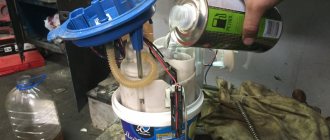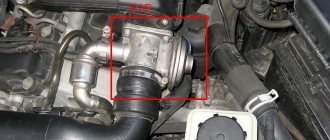Hydraulic compensators: what are they and where are they located?
These elements are an important part of the gas distribution mechanism. These hydraulic compensators can be found directly above the valve. To be more precise, under the camshaft cam.
This part looks like a cylinder. Inside it there is a special check valve, a plunger pair, and a spring. Special channels are made in the walls of the hydraulic compensator. They serve to circulate oil.
Why do hydraulic compensators make noise (knock)
Hydraulic compensators can knock for the following reasons:
- Problems with engine oil.
- The hydraulic compensators are mechanically worn out or damaged.
"Oil" problem
The correct operation of hydraulic compensators greatly depends on such oil factors as:
- quality, freshness, and compliance with engine manufacturer recommendations.
- level.
- pressure.
When the engine oil level exceeds the norm, it foams in the crankcase and loses its homogeneity. Insufficient oil pressure may be due to a faulty pump
Wear and mechanical damage
- During heavy operation of the engine, scoring and dents may form on the body and plunger of the hydraulic compensator. In this case, a characteristic knock will be heard at any speed of rotation of the timing camshaft.
- If the check valve is faulty, the hydraulic compensator will knock on a cold engine, immediately after it starts. But the knocking will stop as the speed increases. Also, knocking may disappear when the engine is warm, also with increasing speed.
- If the plunger pair is worn out, then a knock will appear on a warm engine, but it will not occur if the engine has cooled down a little and is restarted.
Function of hydraulic compensators in the engine
During operation of a car engine, every part of it heats up to high temperatures. The valves are also subject to heat. If you remember the physics course, then at the moment of heating the body expands. This means that the gaps between the valves and rocker arms in the valve mechanism will inevitably decrease.
On older car models with simpler engine designs, valve clearances were adjusted manually. This is not a difficult job, but it requires certain skills, knowledge and a set of tools to complete it. If the gaps are adjusted incorrectly or at the wrong time, certain problems will arise. One of them is a knock, which is familiar to every owner of such a car. This noise indicates that the gaps are too large.
Small gaps also led to certain problems. Because of this, the valve did not close tightly. It was necessary to adjust the mechanisms quite often, since during the operation of the motor the settings were constantly lost.
Thanks to the introduction of hydraulic compensators, the car owner no longer needs to adjust valve clearances. Now this is done automatically. In other words, the presence of hydraulic compensators in the engine design significantly simplifies the engine maintenance process, increases the life of the valve mechanism, and provides the engine with more elastic and stable operation.
Types of parts
Hydraulic compensators are widely used in timing systems, but their analogues are also used in tensioning chains. There are currently four main part designs known:
- hydraulic pusher. It is most often installed on modern car models. The device helps regulate the size of the hole between the valve and the camshaft;
- hydraulic support;
- hydraulic support for the lever and rocker arm. Most often, such parts were used on old timing mechanisms;
- hydraulic pusher on rollers.
All four of these models can be installed on different, different designs. Hydraulic mounts are more suitable for engines of older cars. Currently, more and more manufacturers are beginning to use hydraulic pushers in their designs. It is important to understand the specifics of their work.
Wrong choice of oil
Noises on a cold engine can occur for trivial reasons - the engine is filled with oil of higher viscosity. Sometimes it does not meet the manufacturer’s requirements or has expired.
When buying a car secondhand, it is recommended to immediately change the oil to a new one. Also, before replacing, you need to flush the inside of the engine. This can be done simply with your own hands in a garage. Experts recommend using semi-synthetic fluids. If the oil has been changed, but the knocking of the hydraulic compensator when cold is still heard, it is worth considering other reasons.
Advantages and disadvantages
This device has many positive characteristics. These include:
- the mechanism operates automatically, it does not need to be maintained at all;
- increased timing life;
- maximum pressure indicator, which leads to more complete traction;
- minimum amount of energy consumed;
- In this case, the engine operates quietly.
But despite modern technology, the mechanism also has its drawbacks. These include:
- the entire operation of the device is based on the passage of oil from one point to another. It is for this reason that it is important to fill only good lubricants into the device. It is best to choose synthetics for this;
- you need to change the oil as often as possible;
- requires expensive repairs.
How to check the performance of hydraulic compensators
How to check hydraulic compensators on a VAZ? By removing the valve cover, you can gain access to these elements. Next, press on each of them with a finger. If a part fails, it will be recessed without effort.
In this situation, it will no longer be possible to restore the element. Only replacement will help. How much it costs to replace hydraulic lifters depends on the car model and engine. So, for most VAZ models this operation will cost five thousand rubles. If imported spare parts are selected, then the price will be 7-10 thousand. Naturally, this is not an exact cost - specific figures depend on the region and make of the car. If the mechanism is recessed only from serious force, then flushing the hydraulic compensators will help restore functionality and eliminate the knocking.
Purpose of hydraulic compensators and possible consequences of their malfunction
Most often, the main reason for such a knock is an increase in the thermal gap between the elements of the engine gas distribution mechanism. The permissible value of such a gap is determined by the characteristics of the power unit and is usually in the range from 0.1 to 0.4 mm. If previously the adjustment had to be done manually, every 10-15 thousand kilometers of the car, now the vast majority of cars are equipped with hydraulic compensators with the possibility of automatic adjustment.
Compliance of the thermal gap with the required standards is an important element of proper engine operation. Moreover, if the value exceeds the required norm, the following extremely undesirable processes occur in the car engine:
- increased wear and possible destruction of intake and exhaust valves;
- the appearance of chips on other timing elements;
- possible deformation of the cylinder head;
- contamination of the engine oil with wear products and, as a consequence, an increase in friction in the engine with loss of power and excessive fuel consumption.
As the gap decreases, compression in the engine cylinders drops and its power automatically decreases.
Given these consequences, it is very important to monitor the condition of the hydraulic compensators and promptly respond to the appearance of knocking. https://www.youtube.com/embed/s_xUugmLISo
Preparing for washing
So, if there is a knocking sound, but the hydraulic fluids are in good working order, then you should wash them. To do this, remove the air filter and cylinder block cover. The rocker arm axles, where the hydraulic compensators are located, are also dismantled. They are carefully removed from their seats. Before washing, prepare three containers, which together have a volume of about five liters.
Before washing, you should let the car sit in the garage for a day. During this time, the oil will drain from the hydraulic fluid into the pan. Flushing hydraulic compensators will be successful and effective if done indoors, where there is no dust and wind. Kerosene or A-92 gasoline can be used as a flushing liquid. But you can also use specialized products.
Replacing hydraulic compensators on a Priora (16 valves)
For work, prepare the following tools:
- flat-head, Phillips-head screwdriver;
- socket wrenches;
- You may need a cylinder head gasket; replacing it will allow you to be safe from the fact that the spark plugs may flood the spark plugs with oil;
- sealant;
- magnet - for convenience.
Replace expansion joints on a Priora car according to the instructions:
- Stop the car with the handbrake. Lift the hood.
- Loosen the clamp securing the crankcase ventilation hose (main circuit).
- Disconnect the hose from the cylinder head fitting. Cover the fitting with rags to prevent any objects from getting inside.
- Remove the bracket for the wires of the injectors and ignition coils, having first unscrewed the bolts with the “10” head.
- Disconnect the throttle assembly wiring harness from the cylinder head, having first removed the fastenings with the same head.
- Let's move on to the cylinder block cover. All fifteen screws will have to be unscrewed. To do this, use the E-8 head. Please note that it is additionally secured with sealant.
- Therefore, use a plastic screwdriver to carefully pry the cover in places where there are visible gaps, and then lift it. At this point, evaluate the camshaft lobe wear. It should not be covered with chips or other signs of mechanical damage.
- Now you can check the faulty hydraulic compensators. Avoid damaging the valves of the gas distribution mechanism; handle them carefully.
- Remove the faulty hydraulics with a magnet and put new ones in their place, securing them in a level position.
- Along the way, you should inspect all parts, assessing the degree of wear. This will help to find the reasons for the wear of the hydraulics or the consequence - something that has worn out faster due to their improper operation.
- Replace sequentially. Do not forget to coat the cylinder head cover with sealant to ensure maximum adherence to the body.
- Reassemble the components in reverse order, check the operation of the new hydraulic tappets by starting the engine.
Instructions, procedure
After dismantling the expansion joints, they are cleaned from the outside with brushes with artificial bristles. Then the parts are washed in the first container, which has previously been filled with liquid for washing hydraulic compensators. Each element is lowered into the container and the check ball valve is pressed several times with a wire. Then press on the plunger.
If the stroke of the plunger becomes easy, then the compensator is washed in a second container. However, before this, all liquid is drained from the compensator. To do this, just squeeze the ball. The oil circulation channels are washed using a syringe.
An important point in performing this operation is checking the mechanisms. So, by lowering the compensator into the third container with a cleaning agent, liquid is drawn into the part.
Then the part is lowered and pulled out so that the plunger faces up. If you press your finger on it, it will not move. When everything is exactly like this, the parts are returned to their place and the engine is assembled.
Using this simple procedure, you can restore the hydraulic compensators to their functionality. Even an expensive Liqui Moly hydraulic compensator flushing additive will be no more expensive than replacing these elements with new ones.
How does the washing process work?
This procedure, although it will take time, will not cause any particular difficulties if you follow a clear procedure. It must be carried out indoors (can be in a garage) without drafts and dust in the air. It’s worth noting right away that it won’t be possible to clean the hydraulic compensators without completely disassembling the engine. However, there is also no need to unscrew the power unit to the last screw.
Before starting work, it is necessary to prepare three containers, the depth of which will allow the expansion joints to be completely immersed in the flushing liquid. As such, you can use high-quality 92 gasoline or kerosene. In addition, it is recommended to leave the car in the garage for 24 hours before the procedure, so that as much oil as possible can drain into the pan.
So, the procedure will be like this:
- You need to turn off the power to the car by disconnecting the battery. This is a safety precaution and should not be neglected.
- Disconnect the air filter.
- Remove the cylinder head cover. To do this, you need to unscrew the bolts with the appropriate key.
- Remove the rocker arm axles and remove the hydraulic compensators from their sockets.
- Clean the outside of the parts using a synthetic bristle brush.
Upon completion of cleaning, the hydraulic compensators should be rinsed in the first container. At this stage, each of them must be immersed in the flushing liquid and pressed on the ball valve several times using a wire through the hole in the plunger. Press carefully so as not to break the spring. After this, you need to press the plunger.
When its movement becomes easy, the same procedure must be repeated in a second container with gasoline or kerosene. But before this, you should thoroughly drain the liquid from the compensator by squeezing out the valve ball. Additionally, you can rinse the channels in the compensator body using a syringe.
We also recommend reading the article about why hydraulic lifters knock when cold. From this article you will learn about sleep causes and ways to diagnose the problem.
Another important step is verification. To do this, after dipping the part into the third container, you should draw liquid into the fluid, then release the valve and remove the part from the container with the plunger up. When you press the plunger with your finger, it should remain motionless. If everything is in order, then you can return the expansion joints to their place, install the rocker arms, the cylinder head cover (the bolts should be tightened from the middle to the edges), and so on.
After assembly, all that remains is to start the engine and let it idle for a few minutes. After washing, hydraulic compensators should not knock at idle speed; also, after cleaning them, knocking should not occur after the internal combustion engine is heated and the unit reaches operating temperatures.
How to wash hydraulic compensators without removing them
For those who are too lazy to remove the main body, you can wash it without dismantling it. So, to do this, the intake manifold is dismantled. Then take any decoking liquid and pour it into each of the cylinders. Next, the engine is turned with the starter. Then remove the cover and douse the compensators with carburetor cleaning agent. It is better to choose a good and expensive liquid. Then they leave the car untouched for a couple of hours.
Then everything is assembled in reverse order. When starting the engine, it is recommended to press the gas to the floor. Smoke will come out of the exhaust pipe and various debris will fly out. They gain high speed and hold it until smoke stops coming out of the exhaust pipe. It is recommended to drive at high speeds for some time. This type of washing of hydraulic compensators without disassembly is very widely used by car owners. However, it is not as effective as with removal.
Life hack: hydraulic compensators for a Priora car with 16 valves, device, price
Compensators are needed for automatic valve adjustment; if they were not there, it would be necessary to adjust the valves every 10 thousand, as on 2109. On the Prior, hydraulic compensators knock under different circumstances - and this is not always a malfunction.
They have a special knock, so experienced car enthusiasts will recognize it almost immediately. A knock that comes from the engine of a Priora car is not a very good sign that should alert you. Each car needs to be approached differently. Therefore, when hydraulic compensators on a Priora knock, make proper preparations for repairs - you need to find out what is the reason for what is happening and how you can eliminate it by correcting the situation. In this article, we have collected for you the main signs: why these parts make noise, whether the car is cold or hot.
Important: Even if the new hydraulic lifters are knocking, this is not a reason to prepare for the worst outcome - it sounds strange, but it is true. This is a VAZ, gentlemen, and everything can happen on it.
These parts have 16 valves on the Priora. (if taken as a complete set) they are not so little. The price starts from 4000 rubles and above. Replacing hydraulic compensators is labor-intensive and I don’t recommend getting into the engine yourself without experience. At a service station, such work for a Priora car will cost from 5,000 rubles and more.
The picture shows the valve seat - and in the middle there is a compensator
Additives and liquids for washing HA
According to most experienced car enthusiasts, only A92 gasoline should be used as the best cleaning agent. Kerosene will also work. Along with these folk remedies, famous manufacturers of auto chemicals offer branded liquids and additives. It must be said that most of these products are ineffective. But many people use them because they know well how much it costs to replace hydraulic compensators. There is a lot of information about a product from Liqui Moly to reduce the knock of hydraulic lifters.
The manufacturer promises that with the help of this additive you can clean not only the expansion joints themselves on any car, but also the valve openings. The additive also improves the lubricating qualities of motor oils. If necessary, the liquid can also be used as a cleaner for the entire lubrication system.
If, for example, the hydraulic compensator of a Niva-Chevrolet knocks due to contamination, then this product copes well with this problem. Reviews from motorists note that there is no need to even drain the oil. It is enough to pour one bottle of this product into the filler neck. In other cases, additives will not help - this is not a cure for all diseases. But the manufacturer still recommends adding the additive at every oil change.
After washing, the same hydraulic compensator of the Niva-Chevrolet stops knocking after 50 kilometers of the vehicle. If you consider how much a new element costs, then the washing price of 400 rubles is a significant saving. But reviews note that this is not always effective. In advanced cases, it is necessary to replace the entire hydraulic compensators.
When are hydraulic compensators washed?
Elements of the car system need to be washed as they become dirty, or preventive measures should be taken regularly, such as wiping them of dirt without removing the engine. There is another problem in which mechanisms need to be cleaned - tapping. However, with this option, it is difficult to do a thorough cleaning with your own hands; with a full wash at the service, experienced specialists will help you professionally get rid of plaque and dirt. Also, expansion joints should be cleaned every 50 thousand kilometers.
Liqui Moly additive for hydraulic compensators: is it worth using?
Oil additive Stop noise of hydraulic compensators Liqui Moli
If, after changing the oil, the hydraulic compensators begin to knock, you can use the Liqui Moly Stop Noise additive.
The modern manufacturer Liqui Moly produces a special additive for engine oil, which allows you to get rid of the noise of hydraulic lifters, which occurs due to insufficient lubrication. The substances contained in the stop noise additive for Liqui Moly hydraulic compensators allow you to clean oil channels even in hard-to-reach places. The lubricating properties of engine oil improve, its viscosity increases, which helps get rid of noise. This additive can be used if the hydraulic compensators start to rattle after changing the oil.
Thus, the hydraulic compensator is an important part in the car, which ensures the correct operation of the engine. The car owner must understand that when a knocking noise occurs, it is necessary to immediately begin to look for its causes. If you can’t find out on your own how to identify a knocking hydraulic compensator, then you should contact a car service center. There, specialists will quickly determine the causes and fix the problem. Sometimes it is possible to eliminate the knocking of hydraulic compensators without disassembling them, but in some cases they will require replacement or repair.
Installation of adjusting bolts.
The installation work is carried out in exactly the same way as in the previous case. The only difference will be manual valve adjustment. To do this, you need a thick probe or indicator.
To take a measurement, you must first align the marks on the camshaft and measure the clearance of valves 8 and 6, then rotate the shaft 180 degrees, and then begin adjusting valves 7 and 4. Then adjust 3 and 1, 2 and 5.
The gap on the valves should be 0.15 millimeters. Only measured on a cold engine. If this value is greater, then valve knocking will appear over time. If you install it less, they may soon burn out.











